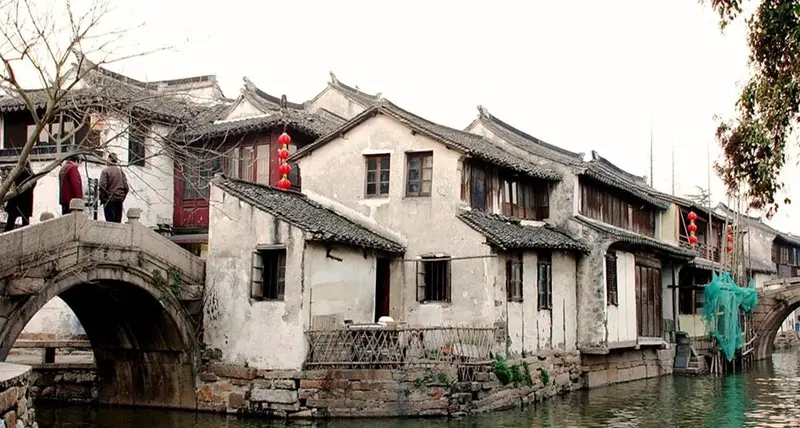Six ancient towns in the south of China, Jasper Zhouzhuang tourist attractions.
There is heaven in the amorous feelings story, Suzhou and Hangzhou under it, and Zhouzhuang in the middle, which has the reputation of being the first water town in the world. Zhouzhuang, Kunshan City, Suzhou, is a street because of water, and a road because of water. Water nourishes Zhouzhuang, which is rich in water. Water is the soul of Zhouzhuang. "There are many alleys in the water town, and people do their best to pillow the river." If it weren't for this quaint Ming and Qing dwellings in beautiful and elegant, this flowing water would be normal. If it weren't for the infinite vitality of this flowing water, the blue tiles and white walls would have been plain. Here, the whole town is a street by the river, connected by bridges and streets, with a deep house compound, heavy ridges and high eaves, a river port in Langfang, an arcade across the street, a bamboo and stone fence and a riverside pavilion, all of which are quaint and quiet, thus "small bridges, flowing water and people" are perfectly combined.
Human Geography Zhouzhuang Town is located 38km southeast of Suzhou City and 33km southwest of Kunshan City. Wu Guanzhong, a famous ancient painter, wrote that "Huangshan Mountain gathers the beauty of mountains and rivers in China, and Zhouzhuang gathers the beauty of China water town", while overseas newspapers call Zhouzhuang the first water town in China. Zhouzhuang has rich cultural connotations. Hans Zhang, a writer in the Western Jin Dynasty, Liu Yuxi and Lu Guimeng, poets in the Tang Dynasty, once lived in Zhouzhuang, an ancient water town with a history of more than 900 years, surrounded by Chenghu Lake, Dianshan Lake and Nanhu Lake. Zhouzhuang's old name is Zhen Ti. In the first year of the Northern Song Dynasty (1086), Zhou Digonglang believed in Buddhism and donated 13 hectares of Zhuangtian to Quanfu Temple as temple property. The common people felt their kindness, so they named it Zhouzhuang. Due to the barrier of rivers and lakes, it has avoided the wars and wars of past dynasties, and still completely preserved the original water town buildings and their unique patterns. More than 60% of the residents in the town are buildings in the Ming and Qing Dynasties. For example, the Shenting built by the descendants of Shen Wansan, a very rich man, and the Zhangting built by the descendants of Xuda, a mountain king in the middle and junior schools of Ming Dynasty, are all examples of Ming and Qing residences. Because of its long age and relatively complete preservation, it provides valuable information for cultural relics, architecture, fine arts, photography and tourism workers. It is really interesting to visit Zhouzhuang and savor the clear water town customs in the quiet atmosphere of Zhouzhuang dwellings.
The main scenic spot Zhouzhuang is surrounded by water, which is Zeguo, Nanbei City River, Hougang River, Youcheyang River and Zhongshi River, forming a "well" shape. Residents build houses by the river, and the streets are built by the mountains. There are 14 ancient bridges across the river, as well as the honest and simple folk customs of the ancient town, showing a quaint, quiet and elegant style, which is a typical "small bridge, flowing water and people" in Jiangnan. No wonder Zhouzhuang has always been the best location for photographers, writers, artists and even TV movies. If you want to choose the most popular ancient water town in China, Zhouzhuang must be among the best. Zhouzhuang is a world of water, which naturally has its unique life form and flavor. That is by no means reflected by one or two ancient buildings or three or four old stone bridges. It's a living breath of life. You can find it by personal observation, or you can feel it without caring: stone revetment and bamboo fence built along the water lane; A variety of cable and ship stones embedded in the shore; Straw shoes sold in shops; Women washing vegetables and washing rice by the river; An old woman sitting around embroidering and chatting; The tailor's shop on the corner; Toilet for sunbathing; Even the sound of running water after washing houses. After all, it is everywhere, and it often becomes a photographer's favorite shot.
1. Shuangqiao is famous for its appearance in Chen Yifei's oil painting "Memories of Hometown", commonly known as Key Bridge. In 1985, this painting was processed by Chen Yifei and became the pattern of the first day cover of the United Nations at that time, which was deeply favored by stamp collectors and people from all walks of life. The bridge deck is horizontal and vertical, and one side of bridge opening is round. It looks like the key used by people in ancient times, so the locals call it the "key bridge". It consists of a stone arch bridge-Shide Bridge and a Liang Shi bridge-Yong 'an Bridge, which were built in the Wanli period of the Ming Dynasty (1573 ~ 1619). This stone arch bridge, called Shide Bridge, spans the North-South River, with a length of 16 meters, a width of 3 meters and a span of 5.9 meters. This Liang Shi Bridge is called Yong 'an Bridge, which is laid flat at Yinzibangkou, with a length of 13.3 meters, a width of 2.4 meters and a span of 3.5 meters. . In the middle of Shuangqiao, the stone arch bridge spans the north-south city river, and there are stone steps approaching the bridge at the east end of the bridge, which extend into the streets. Liang Shi Bridge is flat at the mouth of Yinzibang, bridge opening can only allow boats to pass, and the bridge fence is made of hemp stone.






